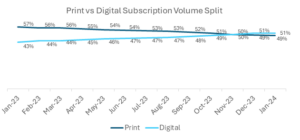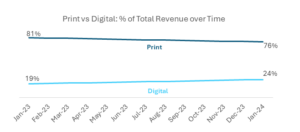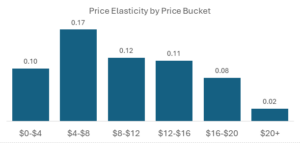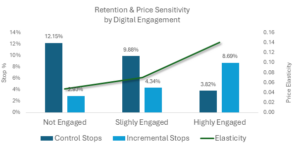By Madelin Zwingelberg, Director of Subscription Analytics at Mather Economics
April 11th, 2024
The Current State of Subscriptions
Publishers have grappled with costly operational hurdles for print subscriptions in recent years, driving a shift towards digital platforms favored by younger demographics. This shift has spurred exponential growth in digital subscriptions, becoming a primary focus for many publishers. The pandemic accelerated this trend, as readers sought rapid and efficient news consumption, prompting a strategic pivot from print to digital priorities. We finally saw digital subscription volume overtake print subscriptions for the first time in Q4 of 2023. However, in the last year we’ve also seen digital subscription growth begin to taper off.

Trends in Print Pricing Strategy
While digital subscriptions have surpassed print subscriptions in terms of volume, print revenue still makes up about 76% of total subscription revenue. After a few years of prioritizing digital growth and strategy, publishers are realizing the need to elongate the print runway while digital platforms continue to develop.

Historically, many publishers have been aggressive on print pricing with multiple increases per year, premium edition charges, and large statement fees. As pricing fatigue begins to set in for various aspects of print subscriptions, publishers are looking to pull back on pricing while still driving the average rate up.
We are starting to see more pricing floors implemented to drive subscription rates while not putting pressure on top-end subscribers. This can be beneficial to help drive profitability, but subscribers below the pricing floor are likely more price-sensitive and less likely to retain. Meaning that price floors alone aren’t going to drive print revenue.

Mather finds that who you price is less important than how you price. Using an algorithmic way to increase subscribers, such as value-based targeting, is going to yield the most revenue while reducing churn. Publishers have been using targeted approaches to print pricing for decades and should continue to do so.
By allocating price increases to subscribers using a targeted approach based on value, publishers can price subscribers on the top end, through inflation or times of major change, with the least amount of impact on retention. Metrics to consider for print subscriptions are delivery frequency, current weekly price, tenure, and past pricing responses, among others.
Trends in Digital Pricing Strategy
Publishers are actively striving to prolong the lifespan of print subscriptions while simultaneously strategizing to bolster their presence in the digital realm. As digital subscriptions continue to claim a larger share of overall subscriptions, optimizing revenue distribution becomes paramount.
A significant factor contributing to the rapid growth of digital volume over digital revenue is the prevalence of low acquisition offers. From the onset of creating digital content, publishers have frequently employed low introductory offers, such as $1 for 6 months, to drive subscription numbers. While effective in boosting volume, these tactics often result in comparatively low digital subscription revenues.
Initially, many publishers hesitated to adjust digital subscription rates, fearing pricing fatigue among subscribers. They relied on stepped-up pricing strategies with small movements between rates at certain increments of time. However, in recent years we have witnessed a shift towards more data-informed, targeted pricing strategies. Data shows that digital subscribers tend to exhibit lower price sensitivity compared to their print counterparts, giving publishers the confidence to price digital subscriptions at higher rates.

Although digital subscribers may be less price sensitive, leveraging personalization remains the most effective means to optimize yield and retention rates. Tailoring subscription rates based on user behavior and engagement levels is crucial, as not all digital subscribers are alike.
Despite the misconception that highly engaged subscribers should be priced more aggressively, research indicates that they are more sensitive to price increases. Therefore, a nuanced approach to pricing, informed by user behavior and personalization, is essential for maximizing retention and revenue in the digital subscription landscape. Publishers should look at engagement metrics such as time on site, web visits, newsletter engagement, and recency. Keep in mind that the greatest influences on pricing sensitivity can vary from market to market even within the same parent company.

As we explore the evolving landscape of subscription pricing strategies, it becomes evident that a nuanced and data-informed approach is crucial for publishers seeking to maximize revenue and retention in both print and digital realms. Now, as we turn our attention to the broader implications of these trends, let’s consider the key takeaways and actionable steps moving forward.
Moving Forward
Despite the surge in digital subscriptions, print revenue still holds significant importance, necessitating a balanced approach between the two mediums. Publishers must carefully address pricing fatigue in print subscriptions while leveraging targeted pricing strategies to drive revenue without sacrificing retention.
As publishers navigate the ever-evolving landscape of subscriptions, whether it is print or digital, a one-for-all approach to pricing does not work in the newspaper world. It needs to be tailored based on behaviors to maximize revenue and reduce churn.
Moving forward, publishers should prioritize data-informed approaches to pricing, continually refining strategies based on market dynamics and consumer preferences. By embracing personalization and targeting, publishers can not only optimize revenue distribution but also enhance subscriber satisfaction and loyalty in an increasingly competitive media landscape.
As we navigate these trends and insights, it’s essential for publishers to remain agile and adaptive, seizing opportunities for innovation and growth in the pursuit of media sustainability.
Don’t miss out on further insights into subscription pricing! Check out our recap from our Pricing Fundamentals webinar and register for our follow-up webinar here, where we’ll delve into strategic and tactical requirements for implementing a targeted-based approach to pricing.


